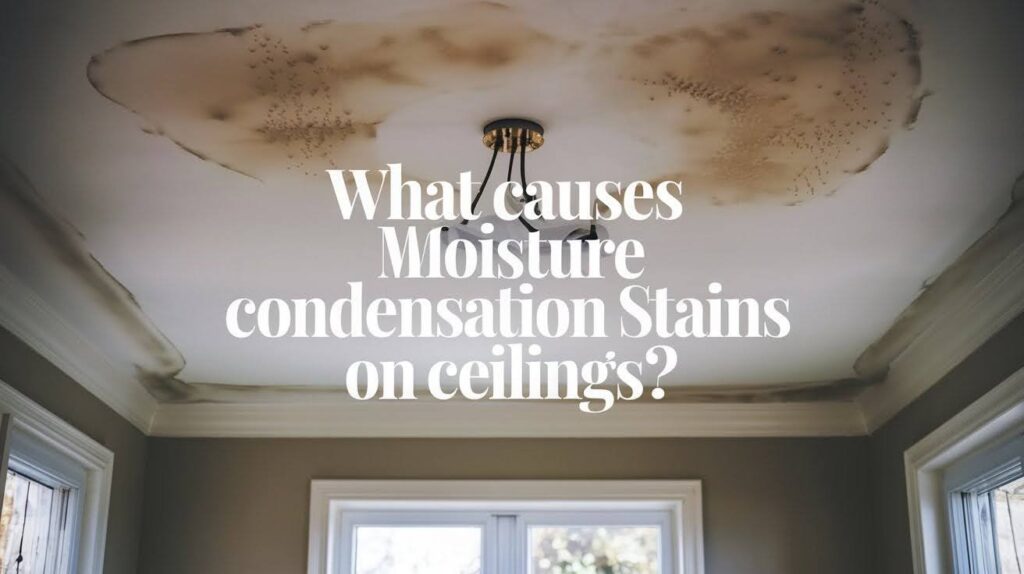Have you ever looked up and spotted those ugly brown or yellow marks spreading across your ceiling?
You’re not alone. Those unsightly spots are condensation stains, and they’re trying to tell you something important about your home.
Here’s the thing: these stains aren’t just cosmetic problems. They signal moisture issues that can lead to serious damage if ignored. Mold growth. Structural problems. Expensive repairs.
But what’s causing them?
The culprits are usually hiding in plain sight. A leaky roof after last week’s storm. Old plumbing pipes are sweating behind your walls. Poor ventilation traps humid air in your bathroom.
Sound familiar?
Don’t worry. Once you understand what’s happening, you can fix it. Let’s figure out what’s going on in your home.
Understanding Moisture Condensation Stains
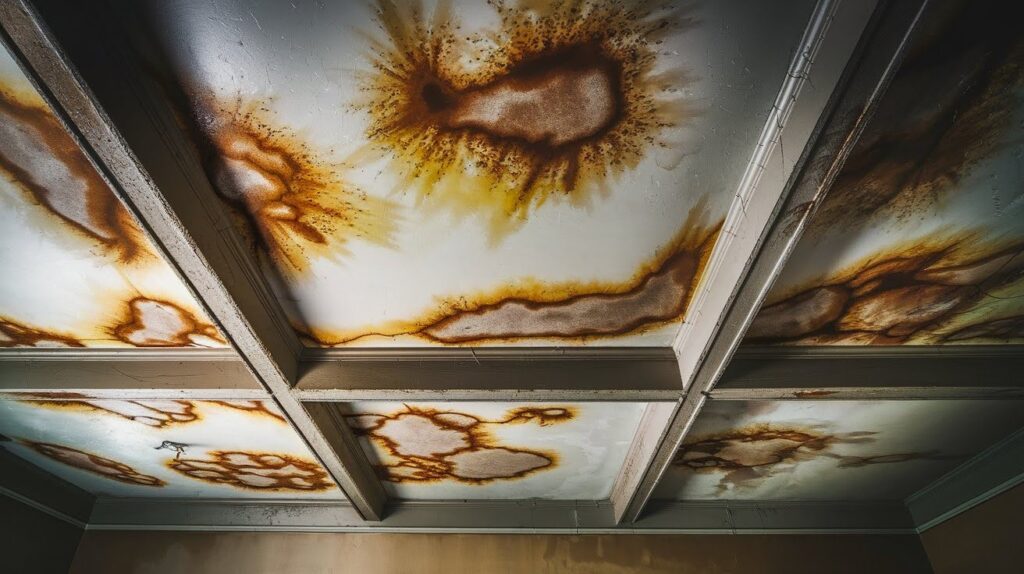
Condensation stains are watermarks that appear on ceilings when moisture gets trapped and has nowhere to escape properly.
What Do Ceiling Condensation Stains Look Like?
Ever wonder if that spot on your ceiling is a problem? Here’s how to tell.
Most condensation stains show up as brown or yellow patches. Sometimes they’re gray. The color depends on what’s mixed with the water.
The shapes vary too. Some stains spread in weird, irregular patterns. Others form straight lines where water follows ceiling joints or beams.
Your nose knows something’s wrong before your eyes do. That damp, musty smell hits you when you walk into the room. You might notice paint starting to bubble or peel around the stained area.
These signs mean water has been there for a while.
Why Do Condensation Stains Form?
Think of your home as a giant sponge. It’s constantly absorbing and releasing moisture.
Indoor humidity is normal. We breathe it out. We create it when we shower, cook, or do laundry. But problems start when that moisture has nowhere to go.
Poor ventilation traps humid air inside. The water vapor rises and hits your cool ceiling. That’s when condensation happens.
But here’s the tricky part. The stain you see might not be where the actual problem started. Water is sneaky. It can travel along pipes, through wall cavities, or across ceiling joists before finally dripping down and creating that visible mark.
That small stain could be the end result of a much bigger moisture issue happening somewhere else in your home.
Common Causes of Ceiling Moisture & Condensation Stains
Your ceiling stains have to come from somewhere. Let’s track down the usual suspects.
1. Roof-Related Causes
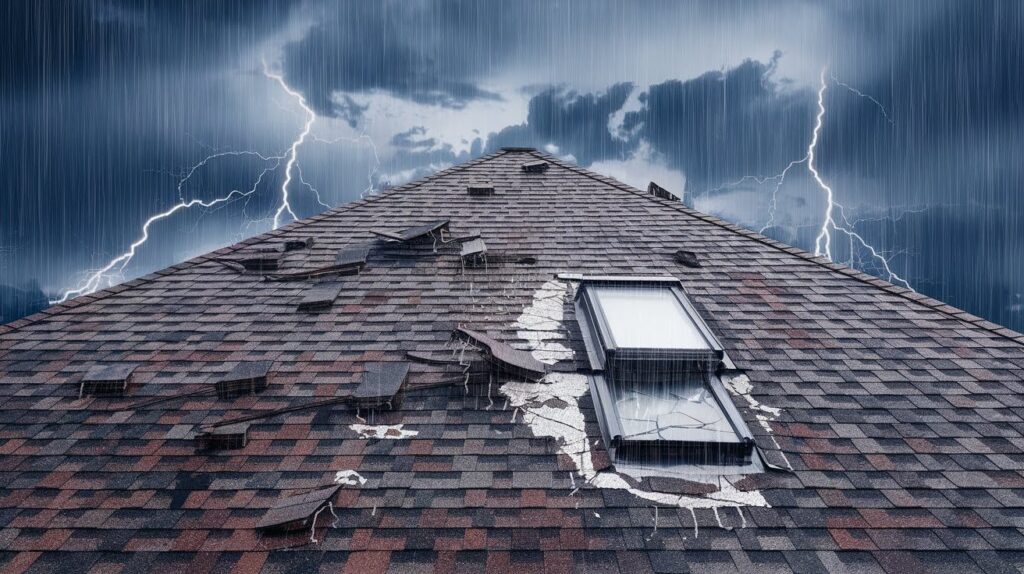
Your roof takes a beating every day. Sun, rain, wind, and time all work against it.
Missing or damaged shingles create easy entry points for water. One loose shingle can let gallons of water into your home during a storm.
Hail hits hard. Those little ice balls can crack shingles and create tiny holes you can’t see from the ground. Wind lifts shingles and breaks their seal.
Heavy rain finds every weak spot. It pools in gutters and seeps through small cracks.
But here’s what many homeowners miss. Flashing is the real problem maker. Those metal strips around your chimney, vents, and skylights are supposed to keep water out. When they crack or pull away, water pours right in.
2. Plumbing Issues
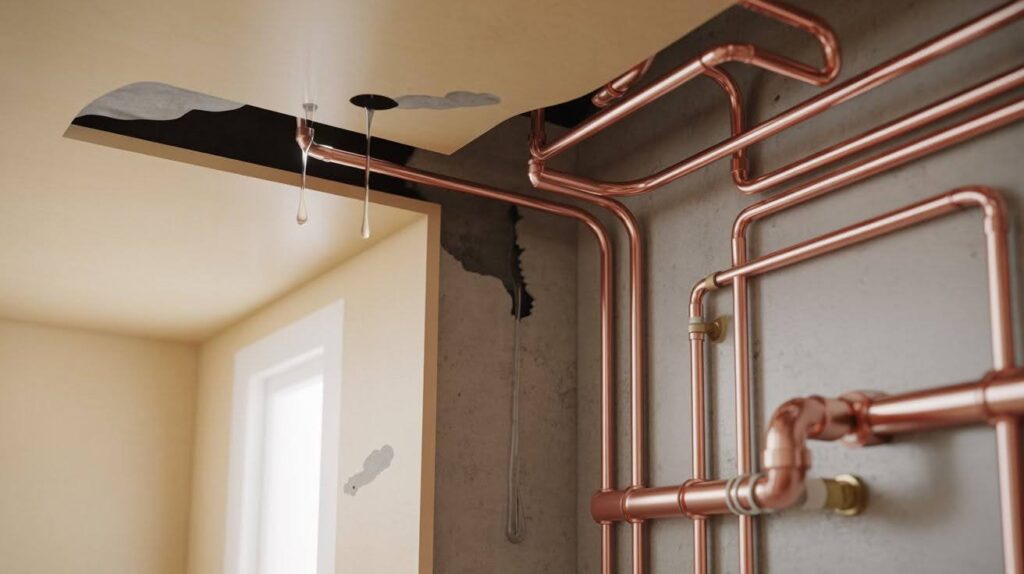
Water pipes run everywhere in your home. Behind walls. Above ceilings. Under floors.
Bathroom and kitchen pipes work the hardest. They handle hot and cold water all day long. That constant expansion and contraction weakens joints over time.
Your toilet might look fine, but the wax seal underneath could be failing. Same with sink gaskets and loose fittings. These small failures add up to big problems.
The worst leaks happen where you can’t see them. Inside walls. Above ceilings. These hidden pipe leaks can run for months before you notice the ceiling stain.
3. Condensation & Ventilation Problems
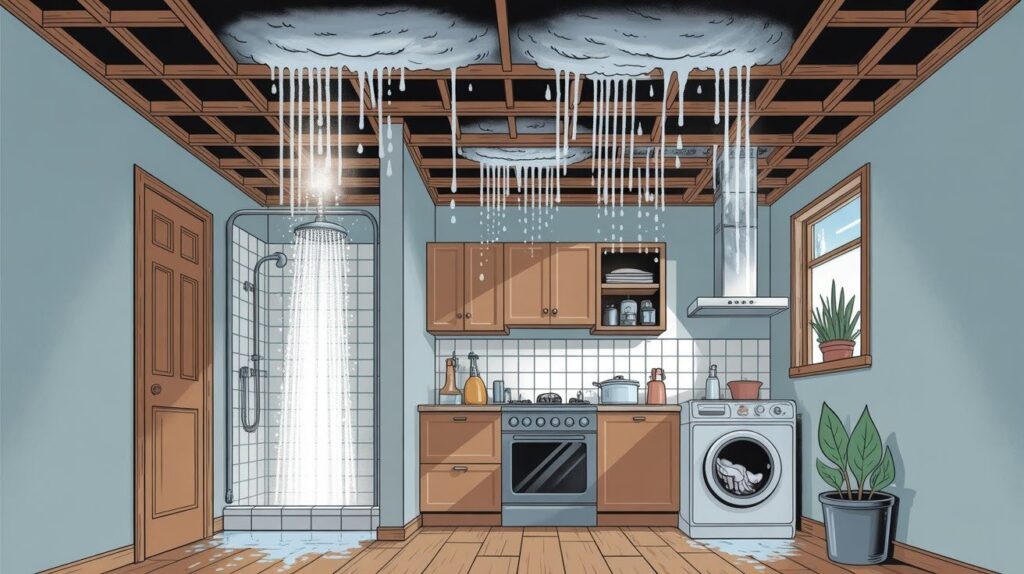
Your daily routine creates more moisture than you realize.
Hot showers fill bathrooms with steam. Cooking sends vapor into the air. Washing clothes adds humidity to laundry rooms.
This moisture needs somewhere to go. Without proper ventilation, it gets trapped. It rises to your ceiling and condenses when it hits the cool surface.
Poor attic ventilation makes things worse. Hot, humid air gets stuck up there with nowhere to escape. It builds up and eventually finds its way into your living space.
Bad insulation creates temperature differences between your warm indoor air and cool ceiling surface. That’s the perfect recipe for condensation.
4. HVAC System Problems
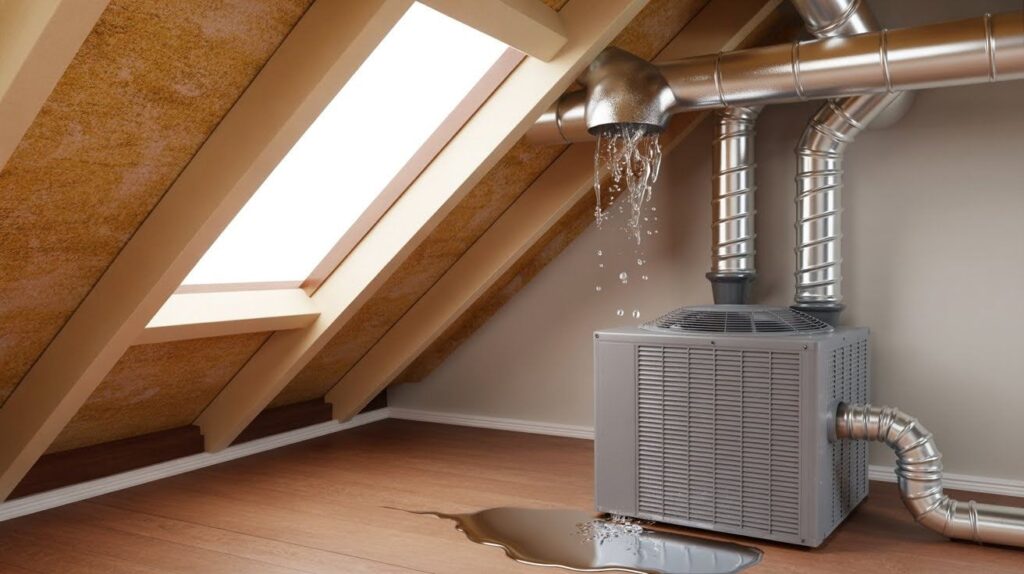
Your heating and cooling system moves a lot of air and water around your home.
AC drain lines carry away the water your system pulls from humid air. When these lines get clogged with algae or debris, water backs up and overflows.
Drip pans catch this overflow, but they crack over time. That water ends up on your ceiling instead of going down the drain.
Air ducts in your attic can develop leaks. Cool air escapes and meets hot attic air. The result? Condensation that drips onto your ceiling below.
Systems that don’t get regular maintenance work harder and break down faster. Dirty filters, clogged coils, and worn parts all contribute to moisture problems.
How to Identify the Source of Ceiling Moisture Stains
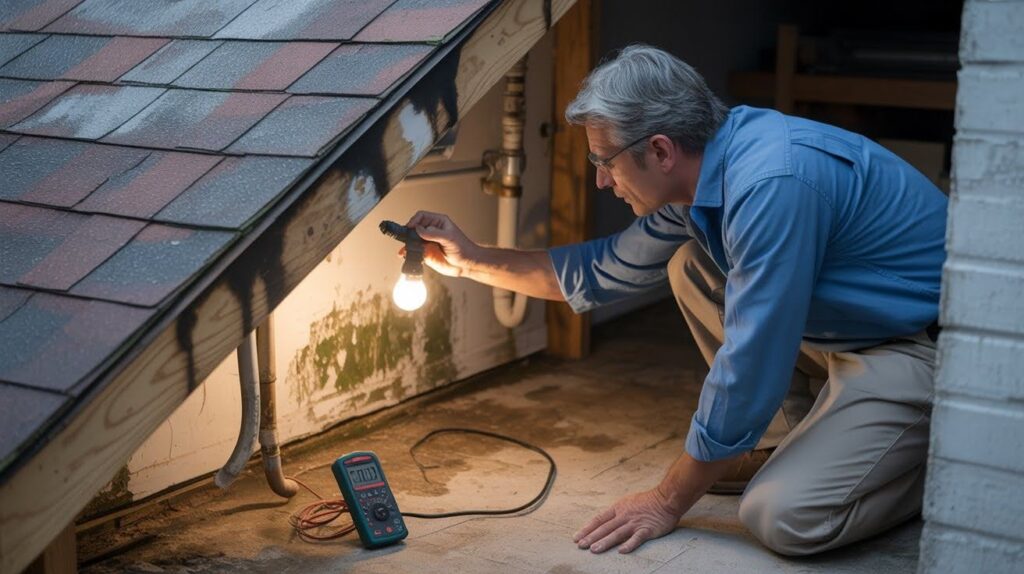
Finding the real cause takes some detective work. But you can do most of it yourself.
Check your roof for missing shingles or damaged flashing. Head to your attic and look for wet spots or damp insulation. Inspect plumbing fixtures and feel around pipe joints for dampness. Look for mold spots that indicate moisture problems.
Listen for dripping sounds in walls. Watch your water bill for sudden increases. Take dated photos of stains to monitor growth. Note any musty smells.
Use moisture meters to detect hidden water. Call roofing professionals for roof damage, plumbing experts for pipe leaks, or HVAC technicians for system issues. Get professional help early to avoid expensive repairs.
How to Prevent Moisture Condensation Stains
Prevention is always cheaper than repairs. Here’s how to stop stains before they start.
- Use exhaust fans in bathrooms, kitchens, and laundry rooms every time you create steam or humidity
- Install attic vents to let trapped moisture escape instead of building up in your home
- Inspect your roof after storms for damage
- Maintain your plumbing systems by checking for leaks and worn seals
- Schedule HVAC tune-ups to keep your system running properly and prevent moisture buildup
- Get professional inspections for your roof and attic every 2 to 3 years
- Have plumbing checks more often in older homes to catch problems early
- Consider moisture assessments in high-humidity areas to identify problem areas before stains appear
Small steps now save you from big headaches later.
Conclusion
Ceiling condensation stains might seem like minor cosmetic issues, but they’re warning signs your home is trying to give you. From roof leaks and plumbing problems to poor ventilation and HVAC issues, these stains point to bigger moisture problems that won’t fix themselves.
Here’s what I’ve learned after years of dealing with these issues: catching them early makes all the difference. That small brown spot today could become a major mold problem and expensive structural damage tomorrow.
Don’t wait until the stain spreads or that musty smell gets stronger. Check your roof, inspect your plumbing, and improve your ventilation now. Your future self will thank you when you avoid those costly emergency repairs.
Take action today. Your home is counting on it.
Frequently Asked Questions
What are the most common causes of ceiling moisture stains?
The main culprits are roof leaks from damaged shingles or flashing, plumbing issues like hidden pipe leaks, and poor ventilation that traps humid air. HVAC problems such as clogged drain lines or leaky ducts also contribute to ceiling stains.
How can I tell if a ceiling stain is from condensation or a leak?
Condensation stains usually appear gradually and worsen during humid weather or after activities like showering. Leak stains often show up suddenly after storms and may have visible water dripping or a strong musty smell.
Can I fix small ceiling stains myself, or do I need a professional?
You can clean small, dry stains with a mild bleach solution once you’ve fixed the moisture source. However, if the stain is growing, you smell mold, or can’t find the cause, call a professional to prevent bigger problems.
How long does it take for ceiling stains to appear after water damage?
Visible stains can appear within 24-48 hours of water exposure, but sometimes take weeks or months to show up. The timing depends on the amount of water, air circulation, and ceiling materials.
Will ceiling stains go away on their own if I fix the moisture problem?
No, existing stains won’t disappear even after fixing the moisture source. You’ll need to clean and possibly repaint the affected area once everything is completely dry and the underlying problem is resolved.

